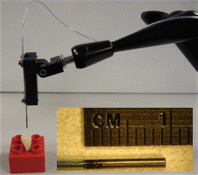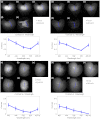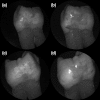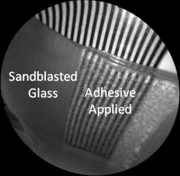Spectrally enhanced imaging of occlusal surfaces and artificial shallow enamel erosions with a scanning fiber endoscope
- PMID: 22894502
- PMCID: PMC3602825
- DOI: 10.1117/1.JBO.17.7.076019
Spectrally enhanced imaging of occlusal surfaces and artificial shallow enamel erosions with a scanning fiber endoscope
Abstract
An ultrathin scanning fiber endoscope, originally developed for cancer diagnosis, was used to image dental occlusal surfaces as well as shallow artificially induced enamel erosions from human extracted teeth (n=40). Enhanced image resolution of occlusal surfaces was obtained using a short-wavelength 405-nm illumination laser. In addition, artificial erosions of varying depths were also imaged with 405-, 404-, 532-, and 635-nm illumination lasers. Laser-induced autofluorescence images of the teeth using 405-nm illumination were also obtained. Contrast between sound and eroded enamel was quantitatively computed for each imaging modality. For shallow erosions, the image contrast with respect to sound enamel was greatest for the 405-nm reflected image. It was also determined that the increased contrast was in large part due to volume scattering with a smaller component from surface scattering. Furthermore, images obtained with a shallow penetration depth illumination laser (405 nm) provided the greatest detail of surface enamel topography since the reflected light does not contain contributions from light reflected from greater depths within the enamel tissue. Multilayered Monte Carlo simulations were also performed to confirm the experimental results.
Figures
















References
-
- Nahás Pires Corrêa M. S., et al. , “Prevalence and associated factors of dental erosion in children and adolescents of a private dental practice,” Int. J. Paediatr. Dent. 21(6), 451–458 (2011). - PubMed
-
- Jaeggi T., Lussi A., “Prevalence, incidence and distribution of erosion,” Monogr. Oral. Sci. 20, 44–65 (2006).MGUSCU - PubMed
-
- Gandara B. K., Truelove E. L., “Diagnosis and management of dental erosion,” J. Contemp. Dent. Practice 1(1), 1–17 (1999). - PubMed
-
- Attin T., “Methods for assessment of dental erosion,” Monogr. Oral. Sci. 20, 152–172 (2006).MGUSCU - PubMed
Publication types
MeSH terms
Grants and funding
LinkOut - more resources
Full Text Sources
Other Literature Sources

